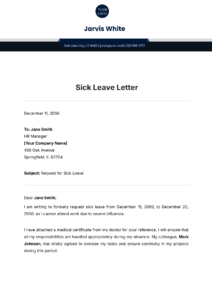Formalized leave requests streamline administrative tasks, reduce misunderstandings, and support accurate record-keeping. They facilitate effective absence management, contributing to smoother workflow planning and minimizing disruption. Clear documentation of leave requests also offers legal protection for both the organization and its employees.
This documentation explores various facets of leave management, encompassing the design and implementation of efficient leave request procedures, the integration of such procedures with broader human resource policies, and the advantages offered by automated systems.
Key Components of a Leave Request Form
Effective leave request forms incorporate essential elements to ensure clarity and completeness. These components facilitate efficient processing and contribute to accurate record-keeping.
1: Employee Information: Full name, employee ID, department, and contact information ensure proper identification and facilitate communication.
2: Date of Request: Recording the submission date establishes a clear timeline for processing.
3: Type of Leave: Specifying the type of leave requested (vacation, sick leave, bereavement, etc.) allows for accurate categorization and adherence to relevant policies.
4: Dates of Leave: Start and end dates of the requested absence period, including specific times if applicable, are crucial for scheduling and workload management.
5: Total Days Requested: The total number of days requested provides a concise overview of the absence duration.
6: Reason for Leave (Optional): While not always mandatory, providing a brief reason for the absence can be helpful for context and planning, especially for longer durations or specific types of leave.
7: Supervisor Approval: A designated space for supervisor signature signifies authorization and ensures proper oversight.
Standardized forms contribute to consistent and efficient absence management, minimizing potential disruptions to workflow and ensuring accurate record-keeping. Each element plays a critical role in conveying the necessary information for effective processing and approval.
How to Create an Employee Leave Request Form
Developing a standardized leave request form involves several key steps to ensure clarity, efficiency, and legal compliance. A well-designed form facilitates effective communication and streamlines the approval process.
1: Determine Required Information: Identify essential data points for accurate record-keeping and processing. This typically includes employee details, date of request, leave type, duration, and supervisor approval.
2: Choose a Format: Select a format suitable for the organization’s needs, whether a digital document, a printable form, or integration with existing software.
3: Design the Layout: Create a clear and organized layout with labeled fields for each piece of required information. Ensure the form is easy to understand and complete.
4: Establish Clear Instructions: Provide concise instructions on how to complete the form, including submission procedures and relevant policies.
5: Incorporate Approval Workflow: Define the approval process, designating appropriate individuals responsible for reviewing and authorizing leave requests.
6: Test and Refine: Pilot the form with a small group to identify potential areas for improvement before widespread implementation.
7: Communicate and Train: Clearly communicate the new procedure to all employees, providing necessary training on how to use the form correctly.
8: Regularly Review and Update: Periodically review the form’s effectiveness and update it as needed to reflect evolving organizational needs and legal requirements.
A well-structured leave request process benefits organizations by improving communication, streamlining administrative tasks, ensuring legal compliance, and facilitating efficient workforce management. Standardized procedures contribute to a smoother workflow and enhance overall operational efficiency.
Standardized forms for requesting time off serve as a crucial component of effective absence management within any organization. They provide a clear and consistent channel for communication, facilitating accurate record-keeping, streamlined processing, and compliance with relevant policies. A well-designed form, incorporating essential information and a clear approval workflow, contributes significantly to operational efficiency by minimizing disruptions and enabling proactive workforce planning.
Implementing and maintaining robust procedures for leave requests empowers organizations to optimize resource allocation, foster a culture of transparency, and ensure equitable treatment for all employees. Effective absence management practices are essential for sustained productivity, employee well-being, and overall organizational success. Regular review and refinement of these processes remain critical for adapting to evolving workplace dynamics and regulatory requirements.
